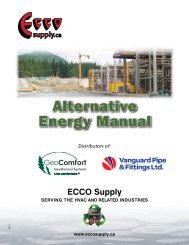Download - ECCO Supply
Download - ECCO Supply
Download - ECCO Supply
You also want an ePaper? Increase the reach of your titles
YUMPU automatically turns print PDFs into web optimized ePapers that Google loves.
HOME Ventilation<br />
Guide<br />
Many ERVs look and operate very similarly to HRVs. An ERV not only conducts<br />
heat but also allows water vapor to pass from one air stream to the<br />
other. In cold weather, moisture is transferred from the exhaust air stream to<br />
the fresh air stream. In warm, humid summer weather, the ERV transfers<br />
moisture from the fresh air stream into the exhaust air stream, which the air<br />
conditioner has cooled. In both cases, this moderates the humidity from the<br />
extreme levels found outdoors.<br />
Selecting a model<br />
There are many different models of HRVs and ERVs, each with its own advantages<br />
and uses. To select the right model for your application, consult HVI’s Certified<br />
Home Ventilating Products Directory, available at www.hvi.org, which<br />
contains performance-testing reports for HVI-Certified HRVs and ERVs.<br />
Airflow is an important consideration when selecting an HRV or ERV, as the<br />
unit’s first function is ventilation. It is critical to select a unit suitable for use in<br />
the climate in which it will be installed. In cold climates, the unit’s frost<br />
protection must be sufficient<br />
“RECIRCULATION”<br />
IS NOT VENTILATION<br />
Ventilation is one of the most<br />
misunderstood parts of any central<br />
heating and air-conditioning system.<br />
Builders, contractors and<br />
homeowners alike may believe that<br />
the home’s ventilation needs are<br />
being met by the central forced-air<br />
system since it provides air<br />
movement and distribution. The<br />
American Society of Heating,<br />
Refrigerating and Air-Conditioning<br />
Engineers (ASHRAE) defines<br />
ventilation for indoor air quality as,<br />
“the process of supplying outdoor air<br />
to or removing indoor air from a<br />
dwelling by natural or mechanical<br />
means.”<br />
Traditional forced-air heating and<br />
cooling systems do not ventilate;<br />
they only recirculate the same air<br />
through the dwelling over and over<br />
again, controlling temperature but<br />
doing little to improve air quality. A<br />
large variety of excellent mechanical<br />
ventilation solutions is available, from<br />
single-point exhaust fans to<br />
balanced supply and exhaust<br />
systems with heat and energy<br />
recovery. Installation of HVI-Certified<br />
ventilation products will help to<br />
ensure optimum indoor air quality.<br />
to ensure that ventilation<br />
will continue throughout the<br />
winter.<br />
Other factors to consider<br />
include “sensible heat-recovery<br />
efficiency,” controls, type of<br />
defrost system and power consumption.<br />
To determine the best choice<br />
for your area, contact HVI<br />
member companies, which<br />
have many years of experience<br />
with HRVs and ERVs.<br />
Control options<br />
The controls for continuous<br />
ventilators range from simple<br />
to complex. Controls are<br />
available that permit variable<br />
ventilation rates, automatic<br />
high-speed operation (when<br />
bathrooms are in use, for example),<br />
automatic operation<br />
to control excess humidity,<br />
timed or proportional operation,<br />
and even air-quality-sensing.<br />
HVI member companies<br />
can provide detailed information<br />
to guide your selection<br />
process. ■<br />
24<br />
circle 66 on reader service card<br />
H V G<br />
www.hvi.org








